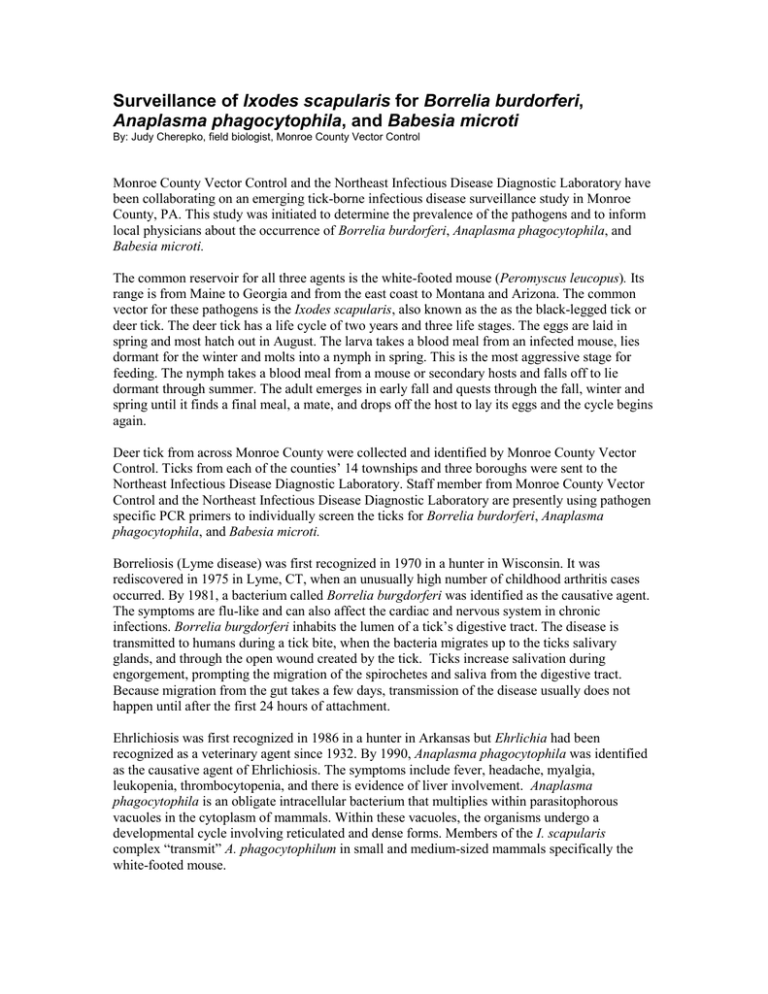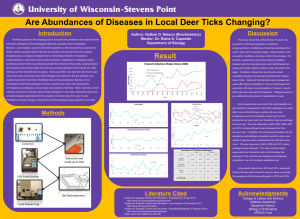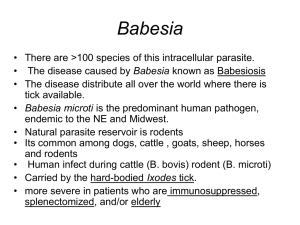Ixodes scapularis Anaplasma phagocytophila
advertisement

Surveillance of Ixodes scapularis for Borrelia burdorferi, Anaplasma phagocytophila, and Babesia microti By: Judy Cherepko, field biologist, Monroe County Vector Control Monroe County Vector Control and the Northeast Infectious Disease Diagnostic Laboratory have been collaborating on an emerging tick-borne infectious disease surveillance study in Monroe County, PA. This study was initiated to determine the prevalence of the pathogens and to inform local physicians about the occurrence of Borrelia burdorferi, Anaplasma phagocytophila, and Babesia microti. The common reservoir for all three agents is the white-footed mouse (Peromyscus leucopus). Its range is from Maine to Georgia and from the east coast to Montana and Arizona. The common vector for these pathogens is the Ixodes scapularis, also known as the as the black-legged tick or deer tick. The deer tick has a life cycle of two years and three life stages. The eggs are laid in spring and most hatch out in August. The larva takes a blood meal from an infected mouse, lies dormant for the winter and molts into a nymph in spring. This is the most aggressive stage for feeding. The nymph takes a blood meal from a mouse or secondary hosts and falls off to lie dormant through summer. The adult emerges in early fall and quests through the fall, winter and spring until it finds a final meal, a mate, and drops off the host to lay its eggs and the cycle begins again. Deer tick from across Monroe County were collected and identified by Monroe County Vector Control. Ticks from each of the counties’ 14 townships and three boroughs were sent to the Northeast Infectious Disease Diagnostic Laboratory. Staff member from Monroe County Vector Control and the Northeast Infectious Disease Diagnostic Laboratory are presently using pathogen specific PCR primers to individually screen the ticks for Borrelia burdorferi, Anaplasma phagocytophila, and Babesia microti. Borreliosis (Lyme disease) was first recognized in 1970 in a hunter in Wisconsin. It was rediscovered in 1975 in Lyme, CT, when an unusually high number of childhood arthritis cases occurred. By 1981, a bacterium called Borrelia burgdorferi was identified as the causative agent. The symptoms are flu-like and can also affect the cardiac and nervous system in chronic infections. Borrelia burgdorferi inhabits the lumen of a tick’s digestive tract. The disease is transmitted to humans during a tick bite, when the bacteria migrates up to the ticks salivary glands, and through the open wound created by the tick. Ticks increase salivation during engorgement, prompting the migration of the spirochetes and saliva from the digestive tract. Because migration from the gut takes a few days, transmission of the disease usually does not happen until after the first 24 hours of attachment. Ehrlichiosis was first recognized in 1986 in a hunter in Arkansas but Ehrlichia had been recognized as a veterinary agent since 1932. By 1990, Anaplasma phagocytophila was identified as the causative agent of Ehrlichiosis. The symptoms include fever, headache, myalgia, leukopenia, thrombocytopenia, and there is evidence of liver involvement. Anaplasma phagocytophila is an obligate intracellular bacterium that multiplies within parasitophorous vacuoles in the cytoplasm of mammals. Within these vacuoles, the organisms undergo a developmental cycle involving reticulated and dense forms. Members of the I. scapularis complex “transmit” A. phagocytophilum in small and medium-sized mammals specifically the white-footed mouse. Babesiosis was recognized in 1960 in New England on Nantucket Island, MA. By 1969 Babesia microti was identified as a causative agent of the disease in humans. The symptoms include fever, chills, sweating, myalgia, fatigue and anemia. The B. microti life cycle involves two hosts, the primary host being the white-footed mouse. During a blood meal, a Babesia-infected tick introduces the infectious agent into the mouse host. The protozoan enters the red blood cells and undergoes asexual reproduction. Within the blood cells, some parasites differentiate into male and female gametes. Deer ticks become infected with Babesia by feeding on an infected white-footed mouse and are capable of infecting humans during a subsequent blood meal. Epidemiologically based Lyme disease case reports on regional, state, and national scales appear to reflect real trends in the disease based upon tick activity and bacterial infection rates, although Lyme disease is clearly underreported (CDC). The rise of active surveillance of human cases and more intensive sampling of I. scapularis nymphs may provide a better assessment of risks within an area of endemicity. This same surveillance will be important for understanding the risks associated with Ehrlichiosis and Babesiosis in Monroe County.






